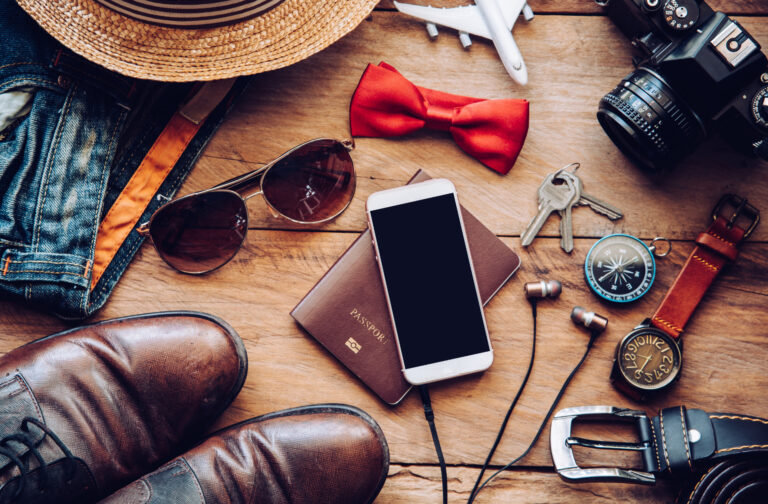We’ve found that timing your Japan trip during shoulder seasons like May-June or mid-September offers the best balance of pleasant weather and manageable crowds.
You’ll want to book accommodations early, learn basic phrases like “sumimasen” (excuse me), and remember essential etiquette like removing shoes in temples and staying quiet on trains.
Download Google Translate for menus, avoid eating during walking, and consider skipping the pricier Japan Rail Pass for individual tickets—there’s much more strategy involved.
Key Highlights
- Visit during quieter periods like December-February or May-June to avoid crowds and enjoy lower accommodation rates.
- Book accommodations and attractions well in advance, especially during peak seasons like cherry blossom and autumn foliage.
- Remove shoes when entering homes, temples, and traditional restaurants; avoid tipping as it’s not customary.
- Download Google Translate for photo translation and learn basic phrases like “sumimasen” to improve local interactions.
- Never eat while walking, speak loudly on trains, or enter onsen with swimwear to respect Japanese customs.
What is the Best Time to Visit Japan for First-Time Travelers?
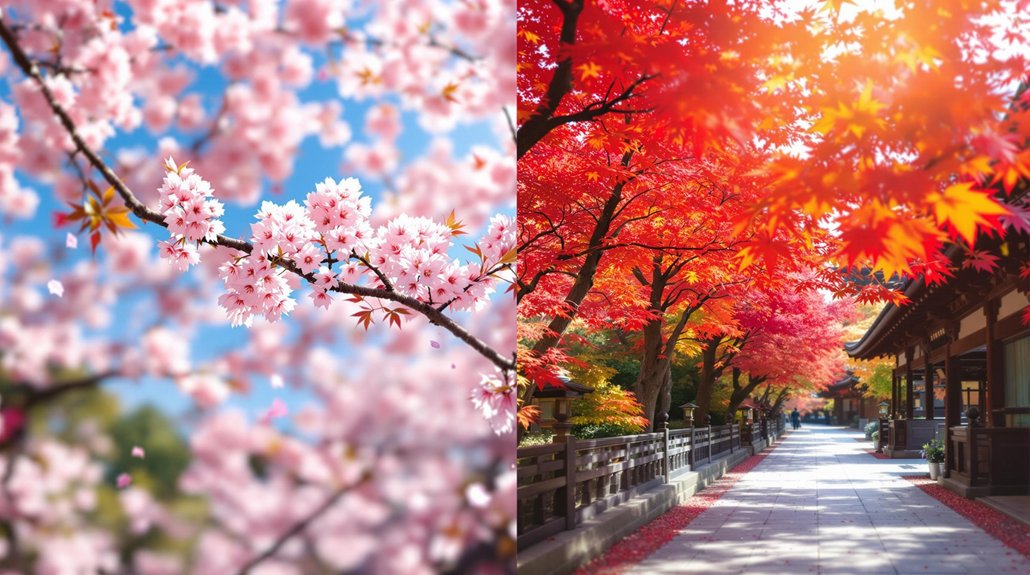
We’ve all struggled with timing our first Japan trip perfectly, and honestly, choosing the right season can make or break your experience!
The key factors we need to consider include seasonal weather patterns, Japan’s incredible festival calendar, and those notorious crowd-heavy periods that’ll have you fighting for space at every temple.
Let’s break down when to visit based on what matters most for your inaugural Japanese adventure.
Seasonal Considerations for Your Japan Trip
Since Japan’s four distinct seasons each offer completely different experiences, choosing the right time for your first visit can make or break your trip!
We’ve learned that spring’s cherry blossoms come with hefty price tags and crowds that’ll test your patience. Summer brings sweltering humidity and rainy season, though mountain hiking becomes incredible.
Autumn delivers gorgeous fall foliage without spring’s chaos, making it our top pick for first-time travelers who want freedom to roam comfortably.
Winter offers the best deals and smallest crowds, but you’ll face snow challenges in northern areas.
We recommend avoiding peak seasons if you value flexibility and budget-friendly travel over Instagram-perfect cherry blossom shots!
Planning Around Japan’s Major Festivals and Holidays
Beyond seasonal weather patterns, Japan’s festival calendar creates another layer of planning complexity that’ll either improve your trip to unforgettable heights or turn it into a logistical nightmare!
Golden Week (April 29-May 6) transforms Japan into domestic tourist chaos – we’re talking packed trains, booked-solid hotels, and prices that’ll make your wallet weep. The public transportation system becomes a sardine can during this period! We made the mistake of traveling to Japan during Golden Week in 2024 but this was planned event in Seoul, South Korea.
Obon Festival in mid-July or August brings similar crowds as families honor ancestors.
New Year’s (January 1-3) shuts down most businesses entirely. Yet, these festivals too offer incredible cultural experiences you can’t find elsewhere.
Our advice? Either plan around these periods for a peaceful trip, or plunge headfirst into the festivities for authentic Japanese culture like we did – just book accommodations months ahead!
Best Time to Visit Japan to Avoid Crowds
Though everyone’s chasing cherry blossoms and autumn leaves, smart travelers know that Japan’s quieter months offer something even better – the chance to experience this incredible country without fighting through selfie sticks and tour groups!
We’ve found the best time to visit Japan is during winter months (December through February), especially mid-January to mid-March when prices plummet and temples feel almost sacred in their emptiness.
May and June likewise let you avoid crowds beautifully – May’s particularly sweet with warm weather and cheaper hotels after cherry blossom chaos ends.
Mid-September to mid-October offers another golden window before autumn foliage madness hits.
Trust us, skip March, April, late October, and November unless you enjoy human traffic jams!
How Should I Plan My Trip to Japan as a First-Time Visitor?
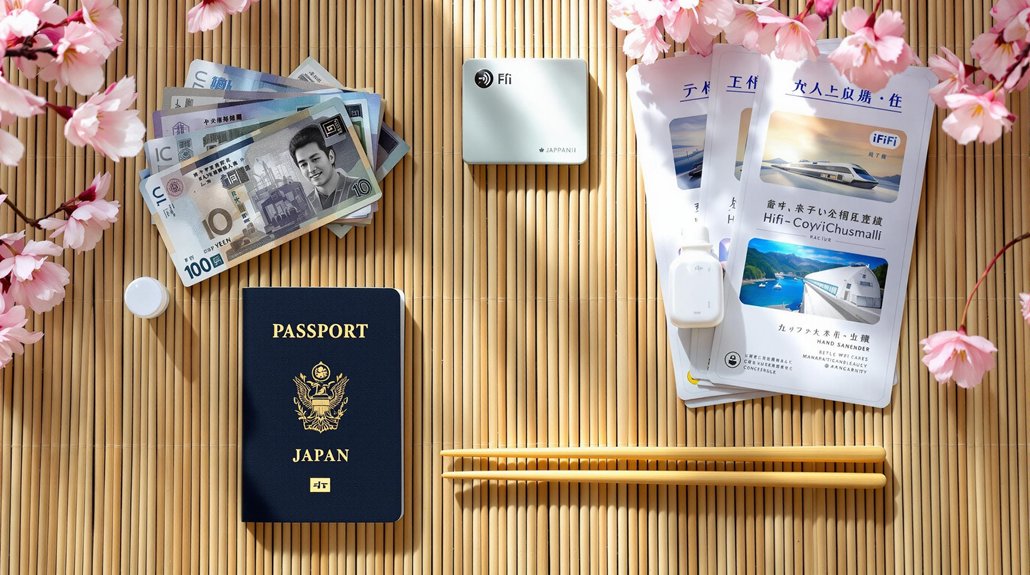
Now that you’ve picked your perfect timing, we need to tackle the actual planning process that’ll transform your Japan dreams into reality.
We’ll walk through the planning steps that every first-timer should master, from creating the perfect packing list for Japan’s unpredictable weather to figuring out exactly how long your adventure should last.
Trust me, getting these fundamentals right will save you from those “I wish I’d known that before I left” moments that can turn a great trip into a stressful one!
Essential Tips for Planning a Trip to Japan
When I first started dreaming about visiting Japan, I made the classic rookie mistake of thinking I could just wing it and figure everything out when I arrived.
I was wrong! Planning a trip to Japan requires some serious preparation, especially during peak seasons like cherry blossom time.
Here’s what I wish I’d known: book accommodations and major attractions well in advance.
Secure restaurant reservations at popular spots – trust me on this one.
For train travel, consider individual tickets over the Japan Rail Pass since recent price increases made it less cost-effective. This is what Amanda and I did on our Japan trip.
Download Google Maps with offline maps of Japan (trust me on this as well!), get a pocket WiFi, and carry cash since Japan’s still largely cash-based.
These japan travel tips will save you countless headaches!
Creating a Japan Packing List for Different Seasons
After my friend spent his first winter in Tokyo shivering in sneakers and a light jacket (rookie mistake number two!), I learned that Japan’s dramatically different seasons require completely different packing strategies.
Now I swear by seasonal preparation – it’s your ticket to comfortable travels without breaking the bank on emergency purchases.
Spring demands layers: light jackets, cardigans, and versatile shirts for fluctuating temperatures.
Summer calls for breathable fabrics, sun protection, and rain gear for humid monsoons.
Autumn mirrors spring’s layered approach, whereas winter requires serious warmth – coats, thermals, waterproof boots, and accessories.
Regardless of season, comfortable walking shoes are non-negotiable.
You’ll visit countless subway stations and temple grounds!
Pro tip: buy umbrellas and heat packs locally – they’re cheaper and better quality than what you’ll pack.
How Many Weeks in Japan is Ideal for First-Time Visitors?
How long should you stay in Japan for your first visit?
We’ve found that 10-14 days hits the sweet spot for first time travelers who want to experience Japan without feeling rushed.
You can cover major cities like Tokyo, Kyoto, and Osaka in one week, but honestly, you’ll be moving at breakneck speed!
Two weeks gives you breathing room to truly soak in the culture and take day trips to Mount Fuji or Hiroshima.
If you’re flying from North America, we strongly recommend at least 10 days to justify that long trip and recover from jet lag.
Amanda and I stayed in Japan for 11 days and traveled up to Kyoto, Osaka, Kobe, and Tokyo. So… it’s doable but 3 extra days would’ve been perfect!
Trust us, after experiencing Japan’s incredible blend of tradition and modernity, you’ll wish you’d planned for three weeks!
Is the Japan Rail Pass Worth It and How Does It Work?

Now that we’ve covered the basics of planning your Japan adventure, let’s tackle one of the most common questions we hear from first-time visitors: is the Japan Rail Pass actually worth your money? TLDR – for most, no.
We’ll walk you through exactly how this unlimited travel pass works, share our best tips for exploring Japan’s incredible train system, and help you plan your public transportation strategy like a pro.
Trust us, getting this part right can save you hundreds of dollars and countless headaches during your trip!
How to Get Unlimited Travel with the Japan Rail Pass
One of the smartest investments you can make for exploring Japan is the legendary Japan Rail Pass, and I’ll be honest—when I first heard about unlimited travel for a flat fee, it sounded too good to be true!
Here’s the secret: you must purchase an exchange voucher before arriving in Japan. I learned this the hard way when my friend tried buying one at Tokyo Station!
The Japan Rail Pass offers unlimited travel on most JR trains, including those famous bullet trains (except the super-fast Nozomi and Mizuho). You’ll exchange your voucher at JR offices in airports or major stations, then enjoy seamless travel using automatic ticket gates.
It’s freedom at its finest! However… it depends on where you’re traveling to.
Tips for Traveling Around Japan by Train
As the Japan Rail Pass gets all the attention (and rightfully so!), mastering train travel in Japan involves so much more than just flashing your pass at the gate.
We’ve learned that Japanese trains run like clockwork—literally to the second—so arriving early at train stations isn’t optional, it’s survival! Trains will NOT wait for you. Trains will leave on time.
The system includes everything from local JR trains making every stop to lightning-fast shinkansen (hello, Hello Kitty train!), and thankfully, major routes feature clear English signage.
We’ll need to follow proper etiquette: keep conversations quiet, avoid phone calls, and always let passengers exit first.
Navigation apps like Google Maps became our best friend, providing real-time updates and fare calculations for seamless travels. I was religiously refreshing Google Maps for the most up to date train schedule because if you miss your train, you can take another train to get to your destination.
Planning Your Travel Around Japan with Public Transportation
How much money can you actually save with a Japan Rail Pass, and does it make sense for every type of trip?
We’ll be honest – the math isn’t always straightforward! The 7-day pass costs around $280, so you’d need to take roughly two long-distance shinkansen trips to break even.
Here’s where it gets interesting: the pass covers ALL JR trains, including local ones within cities. If you’re hopping between Tokyo, Osaka, and Kyoto during your use of JR public transportation daily, you’ll save serious cash.
But if you’re staying in one city or mixing in private train lines, you might come out ahead buying individual tickets.
We’ve found the real value lies in the freedom to travel spontaneously without calculating costs! We ended up buying individual train tickets at the station, which saved us more money than buying the Japan Rail Pass.
What Cultural Etiquette Should I Know Before Visiting Japan?

We’ve covered the logistics of getting around Japan, but now we need to talk about something just as significant – understanding Japanese customs and etiquette before you arrive!
Trust me, knowing these cultural basics will save you from those awkward moments where you’re standing there wondering if you just accidentally offended someone.
Let’s look at the customs you should know, practical etiquette tips for first-timers, and the common cultural mistakes that can easily trip up even well-intentioned visitors.
Essential Things to Know About Japanese Customs
The heart of Japanese culture beats strongest in its customs, and understanding these unwritten rules can transform your visit from awkward tourist moments into meaningful connections with locals.
We’ll explore important Japanese etiquette that’ll help you navigate social situations with confidence.
Bowing replaces handshakes here – a slight nod works for casual encounters, whereas deeper bows show greater respect.
You’ll experience omotenashi everywhere, Japan’s legendary hospitality that expects nothing in return.
Always remove shoes when entering homes, temples, and traditional restaurants.
Gift-giving matters too; bringing omiyage (souvenirs) shows thoughtfulness.
At shrines and temples, purify hands and mouth at washing stations first, then follow proper prayer etiquette.
These customs aren’t just rules – they’re gateways to authentic cultural experiences.
Practical Tips for Your First Time in Japan
Why do some travelers return from Japan raving about respectful interactions whereas others share stories of cultural confusion? The difference lies in understanding cultural sensitivity before you arrive!
We’ve learned that mastering public transportation etiquette transforms your daily experience – keep conversations quiet, avoid phone calls, and respect personal space during rush hours.
The no-tipping culture initially confused us, but we realized that service professionals take genuine pride in their work. At restaurants, we learned to slurp noodles (it’s actually encouraged!) and finish every grain of rice to show appreciation.
Payment involves using small trays rather than handing cash directly to cashiers.
Business card exchanges require both hands and respectful treatment. These simple adjustments unlock Japan’s legendary hospitality and create meaningful connections with locals.
Common Mistakes Visitors to Japan Should Avoid
Even with good intentions and cultural awareness, we’ve watched countless well-meaning travelers accidentally commit cultural faux pas that left them red-faced and locals politely uncomfortable.
These cultural missteps happen faster than you’d think! We’ve seen visitors eating during strolling down busy streets, speaking loudly on quiet train rides, and snapping photos inside sacred shrine spaces without permission.
The most serious etiquette violations occur at onsen hot springs – imagine walking in wearing swimwear or bringing your towel into the communal bath!
We recommend learning basic gestures like using an open hand instead of pointing, removing shoes appropriately, and washing thoroughly before entering any shared bathing area.
These simple awareness tips will save you from awkward moments.
What are the Must-Visit Destinations for a First Trip to Japan?
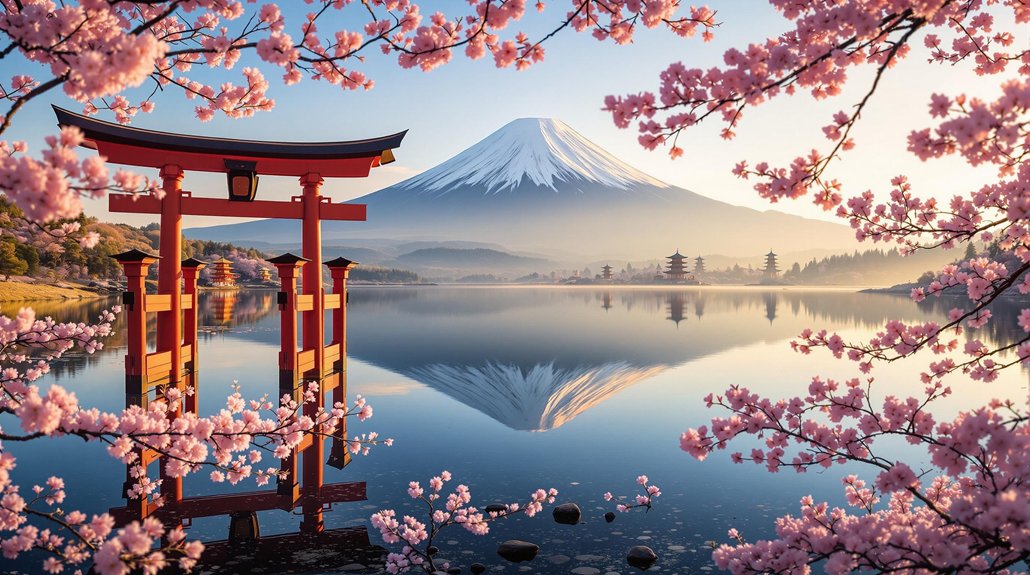
We understand choosing your first destinations in Japan can feel overwhelming with so many incredible places calling your name!
Let’s explore the top experiences that’ll give you the perfect introduction to this amazing country, from the electric energy of Tokyo’s neon-lit streets to Kyoto’s peaceful temple gardens.
We’ll help you craft an adventure that balances those must-see tourist spots with some special hidden gems that’ll make your trip truly unforgettable.
Top Things to Do in Japan for First-Timers
Japan’s incredible diversity hits you the moment you get off the plane – ancient temples stand just blocks away from neon-lit skyscrapers, and that magical contrast is exactly what makes your first trip so unforgettable!
We’ve found the top things to do that’ll give you authentic cultural experiences throughout satisfying your adventurous spirit.
Essential first-timer experiences include:
- Temple hopping – Visit Senso-ji in Tokyo’s Asakusa district and Todai-ji in Nara for spiritual immersion
- Ryokan stays – Experience traditional hospitality with tatami floors and kaiseki dining
- Hands-on activities – Make sushi, participate in tea ceremonies, or bow to deers in Nara Park
Don’t miss riding the shinkansen bullet train or uncovering teamLab’s digital art installations – they perfectly capture Japan’s modern innovation alongside its timeless traditions.
Planning a Japan Adventure Beyond Tokyo and Kyoto
Most first-time visitors stick to the famous Tokyo-Kyoto route, but you’re missing out on Japan’s most authentic experiences if you don’t venture beyond these tourist magnets!
We’ve unveiled incredible alternative destinations that’ll give you genuine cultural immersion without the crowds.
While in Kyoto, discover the beauty of Kinkaku-ji (Golden Pavilion), stroll through the Arashiyama Bamboo Grove, check out the beautiful traditional architecture in Gion, and experience traditional tea ceremonies.
Osaka is known for its food culture, don’t miss Dotonbori for street food, and visit Osaka Castle.
Kanazawa offers traditional gold-leaf workshops and pristine geisha districts in Higashi Chaya, whereas nearby Shirakawa-go showcases UNESCO World Heritage thatched-roof farmhouses.
Hiroshima combines profound history with natural beauty, and Osaka delivers Japan’s legendary street food scene in lively Dotonbori.
For adventurous folks, Hakuba provides world-class skiing in the Japanese Alps, whereas art lovers shouldn’t miss Naoshima’s contemporary installations.
Koyasan offers spiritual temple stays with actual monks!
These authentic local experiences reveal regional cuisines, dialects, and customs that showcase Japan’s incredible diversity beyond typical tourist circuits.
Experience in Japan: Balancing Tourist Sites and Hidden Gems
As everyone tells you to pick either famous spots or hidden treasures, the smartest first-time Japan travelers actually blend both approaches for the ultimate experience!
We’ve learned that iconic tourist attractions like Shibuya Crossing and Fushimi Inari’s thousands of torii gates absolutely deserve their fame—they’re crucial for understanding Japanese culture and getting those Instagram-worthy shots.
But here’s our secret: visit these spots early morning or late afternoon to dodge crowds, then uncover hidden gems like Tokyo’s charming Yanaka district with its preserved wooden houses.
We love finding unexpected treasures like Gotoku-ji temple with thousands of maneki neko cat statues! The key is timing your famous site visits strategically, then diving into local neighborhoods where real Japanese life unfolds organically.
How Can I Navigate Language Barriers When Traveling in Japan?
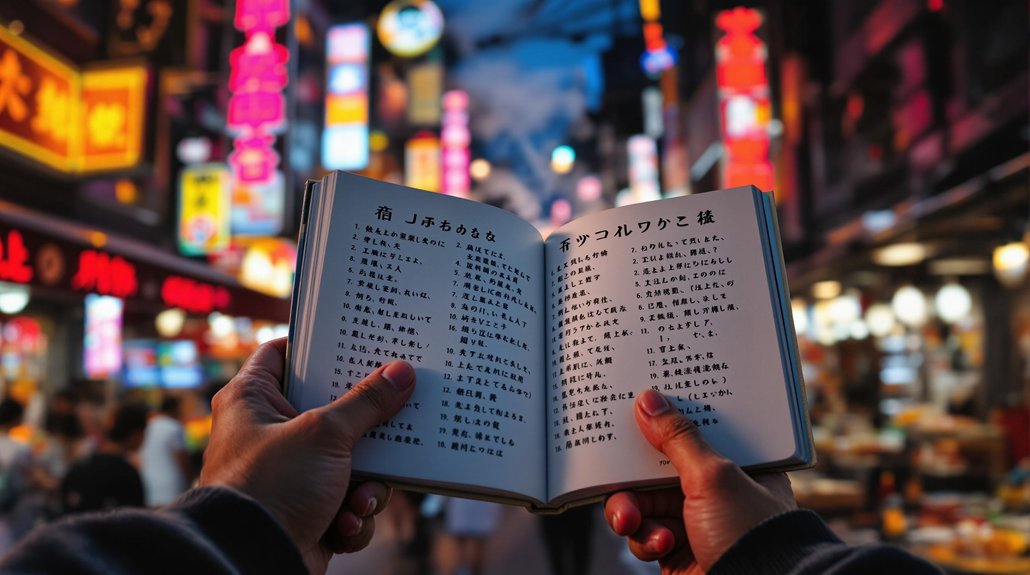
We understand that communicating in Japan might seem intimidating if you don’t speak Japanese, but we’ve uncovered some game-changing strategies that’ll boost your confidence from day one!
Whether you’re ordering ramen or asking for directions, we’ll share the crucial phrases that locals appreciate most, plus the apps that saved us countless times when we were completely lost in translation.
Let’s look at how proper preparation and the right digital tools can transform potential language mishaps into meaningful connections with Japanese culture.
Essential Travel Tips for Communicating in Japan
Although stepping off the plane in Tokyo might feel intimidating when you don’t speak Japanese, traversing language barriers becomes surprisingly manageable with the right preparation and mindset.
Learning basic phrases like “sumimasen” (excuse me) and “onegaishimasu” (please) transforms every interaction!
Download Google Translate before you arrive – its photo feature works magic on restaurant menus and confusing signs.
Rent a portable Wi-Fi device to keep your translation apps running smoothly throughout your adventure.
Don’t underestimate train station information desks either; staff often speak English and they’re lifesavers for ticket purchases.
Remember, effective communication isn’t just about words – gestures and smiles bridge any language barrier.
We’ve found that locals appreciate your efforts, making every conversation more meaningful!
Apps and Tools to Help You Travel Japan Without Speaking Japanese
Technology becomes your best travel companion when traversing Japan’s language terrain, and we’ve tested countless apps to find the ones that actually work when you’re standing confused in a Tokyo subway station at rush hour.
Google Translate shocked us with its photo translation feature – just point your camera at menus and watch kanji magically transform into English!
We recommend downloading the Boutique Japan Tiny Phrasebook for crucial phrases that’ll impress locals.
Duolingo helps you master basic vocabulary before departure, as you navigate and Jorudan apps translate complex train routes into simple directions.
These tools don’t just translate words; they unlock authentic Japanese experiences without language anxiety holding you back from discovering freely.
How to Prepare for Your Japan Travel Experience
Although Japan’s language barrier might seem intimidating at first glance, you’ll find that preparation transforms potential frustration into genuine cultural connections.
We’ve uncovered that downloading language apps before departure makes all the difference in your travel experience. Google Translate‘s camera feature becomes your secret weapon for decoding mysterious menus and street signs! Learning basic phrases like “sumimasen” shows respect and often encourages locals to help you navigate tricky situations.
Don’t underestimate the power of a pocket phrasebook or apps like Pimsleur for building confidence. Whereas major cities offer English support, your efforts to speak Japanese—however broken—create authentic moments that’ll stick with you long after you’ve returned home.
Preparation truly unlocks Japan’s magic.
Frequently Asked Questions
Q: What are some essential japan travel tips for first-time visitors?
A: If you’re planning to visit Japan for the first time, make sure to brush up on basic etiquette, learn a few key phrases in Japanese, and always carry cash, as not all places accept credit cards. Also, don’t forget to plan your trip to Japan around the cherry blossom season for a truly magical experience!
Q: How can I effectively plan my trip to Japan?
A: To plan your trip to Japan, start by deciding which cities you want to explore. Tokyo, Kyoto, and Osaka are must-sees! Use a travel guide to help you map out your itinerary, and consider purchasing a Japan Rail Pass in advance to save on transportation costs across Japan.
Q: What should I know about the language barrier in Japan?
A: The language barrier in Japan can be a bit daunting, but don’t be afraid! Many Japanese people understand basic English, especially in tourist areas. Learning a few phrases can go a long way, and using translation apps like Google Translate can help bridge the gap during your visit to Japan.
Q: What are the best Japan travel tips for budget travelers?
A: If you’re traveling to Japan on a budget, consider staying in capsule hotels or guesthouses, eating at convenience stores (7-Eleven), and using public transportation. Also, check out free activities in Japan, like visiting temples and parks, to keep costs down while enjoying the culture in Japan!
Q: How many days should I spend in Japan?
A: The ideal number of days to spend in Japan really depends on your interests! A week is a good start to cover major cities, but if you want to dive deeper into the culture and activities in Japan, consider extending your trip to 10-14 days. Just remember, time flies when you’re having fun!
Q: What are some must-visit activities in Japan?
A: Must-visit activities in Japan include exploring the historic temples in Kyoto, enjoying the neon lights of Tokyo, and indulging in street food in Osaka. Don’t forget to visit Universal Studios Japan and Tokyo DisneySea!
Q: How can I avoid peak travel times in Japan?
A: To avoid peak travel in Japan, plan your visit during the off-peak seasons, which are typically late autumn and winter. If you must travel during peak times, try to visit popular attractions early in the morning or late in the afternoon to dodge the crowds!
Q: What’s the best way to get around Japan?
A: The best way to get around Japan is by using the extensive train system. The Japan Rail Pass is a great option for tourists, allowing unlimited travel on most trains. Just be sure to plan your routes in advance to maximize your travel experience in Japan!
Q: What are some cultural tips to keep in mind while visiting Japan?
A: When visiting Japan, remember to respect local customs, such as bowing when greeting, removing your shoes before entering homes, and being quiet on public transport. These little gestures will enhance your travel experience in Japan and show your appreciation for the culture!



